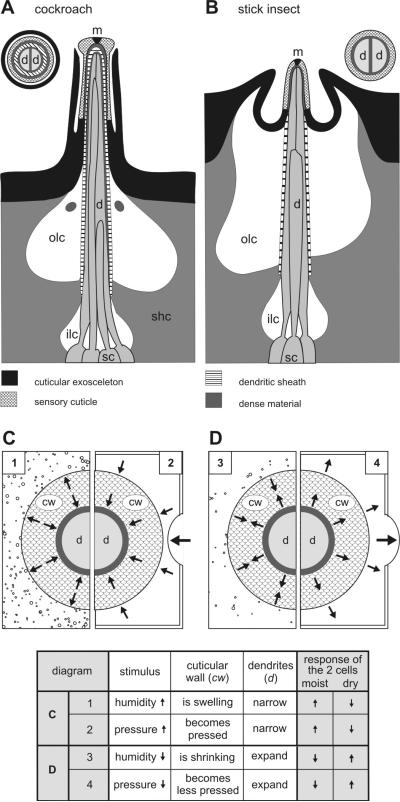Fig. 1.
A-D: Diagram of the hygroreceptive sensilla on the cockroach and stick insect antenna and proposed effects of changes in humidity and air pressure. A and B: the cuticular processes, cellular associations and lymph cavities in longitudinal section. The main feature common to both insects is a thin-walled sensillum cuticle that lacks a pore system to connect the lumen of the dendritic sheath with outside. The molting pore (m) at the tip is plugged by dense material. Of the three or four sensory cells innervating the sensillum, two possess unbranched outer dendritic segments (d) extending up to the apex of the cuticular peg. The dendritic terminals entering the narrow lumen allow only a small space to separate them from the dendritic sheath and from each other. Dense material accumulates in the space towards the apex of the peg. Farther inside, below the base of the peg, the space opens out to form the small inner receptor lymph cavity (ilc). This cavity encloses the central portion of the dendrites between their inner and outer segments, and is surrounded by sheath cells (shc). Outside the sheath there is a more voluminous space, the outer receptor lymph cavity (olc) (after Tichy and Loftus 1996). C and D: proposed effects of changes in humidity (left side in both diagrams) and changes in air pressure (right side in both diagrams) on the cuticular wall (cw) and the dendritic processes (d) of the moist and dry cell. Swelling or expanding of the sensory cuticle, due to its tendency to take up water, increases the discharge rate of the moist cell and decreases that of the dry cell (Tichy 1987; Fig. 1C); conversely, shrinking or contracting of the cuticular wall, due to its tendency to lose water, increases the discharge rate of the dry cell and decreases that of the moist cell (Fig. 1D). The internal pressure increase during swelling is imitated by increasing air pressure (Fig. 1C), and the internal decrease in pressure during shrinking is imitated by decreasing air pressure (Fig. 1D)

